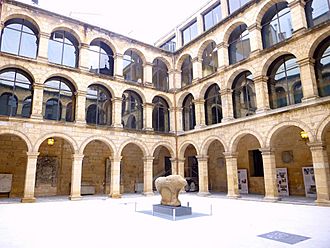Basque Museum facts for kids
Quick facts for kids Basque Museum |
|
|---|---|
 |
|
| General information | |
| Type | Culture and leisure |
| Location | Bilbao, Spain |
| Completed | 1921 |
| Technical details | |
| Structural system | Steel superstructure with reinforced concrete floors |
The Basque Museum is a fascinating place in Bilbao, Spain. It's also known by its longer name: the Basque Archaeological, Ethnographic and Historical Museum. This museum first opened its doors in 1921.
It started in a beautiful old building. This building was once part of the Colegio de San Andrés. This school belonged to a group called the Jesuits a long time ago. The church next door, Santos Juanes, was also part of that old school.
From the very beginning, the museum received help. The local government, like the Vizcaya Provincial Council and the Bilbao City Council, supported it. Over time, the museum grew bigger. It started using more buildings nearby.
Discover the Basque Museum
The Basque Museum is a special place to learn about the history and culture of the Basque Country. It helps visitors understand how people lived in this region long ago.
What You Can See
The museum has many interesting collections. These collections show the history of the Vizcaya area. They also tell the story of the Basque people. You can see ancient tools and objects from the past. You can also learn about the traditions and daily life of the Basque Country.
A Look Back in Time
The museum is always working to improve. It is currently being updated. This means they are making the exhibits even better. They are also improving how the museum works behind the scenes.
Since 1962, the Basque Museum has been very important. It is recognized as a National Historic-Artistic Monument. This means it's a protected and valuable part of Spain's heritage.
See also
 In Spanish: Museo Vasco (Bilbao) para niños
In Spanish: Museo Vasco (Bilbao) para niños

